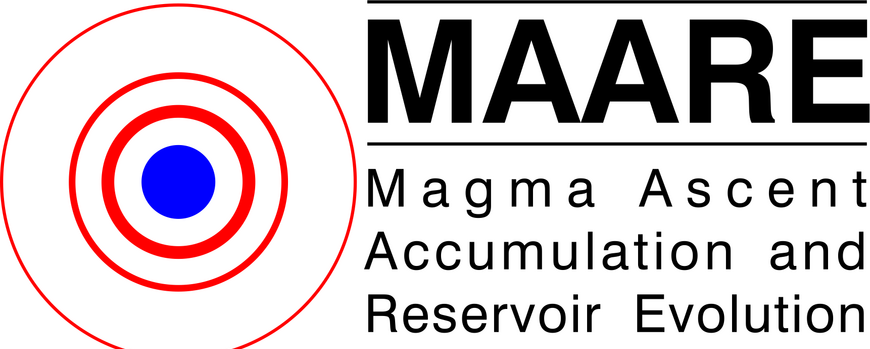The MAARE Research Initiative
MAARE is an interdisciplinary research initiative coordinated by the Universities of Potsdam, Heidelberg, Mainz, Munich (LMU), Jena, Aachen and the German Research Centre for Geosciences GFZ to enhance our understanding of magma ascent, accumulation and reservoir evolution in intra-continental settings. Examples of core questions addressed by the MAARE research initiative comprise:
- What are past and current conditions in transcrustal magmatic reservoirs at different depths?
- How do magmatic fluids migrate through the crust and how do they trigger reservoir unrest?
- What are the spatio-temporal controls on volcanism in low-flux systems?
- What are realistic eruption scenarios and forecast uncertainties in low probability, high impact volcanic regions?
- How can distributed volcanic fields be monitored in a comprehensive manner and how can small precursory signals reliably be interpreted?
- What are pitfalls in communicating volcanic hazard research and risk?
Submitted proposal: Magma Ascent, Accumulation and Reservoir Evolution (MAARE)
Summary
Volcanic eruptions are the most tangible and impactful events at the end of a long process chain starting with melt generation in the Earth’s upper mantle, and followed by upward transfer of magma and fluids that is accompanied by segregation of crystals and gasses at various depths. Traditional models of volcanic plumbing systems emphasize the role of shallow magma accumulations beneath volcanoes, but fail to explain many surface observations in volcanically active terrains, either from geophysical data or eruptive records. A recently emerging concept is that of a transcrustal magma system, which comprises a dynamic network of tabular intrusions interconnected by subvertical conduits and feeder channels. In this view, transient magma reservoirs comprise isolated pockets at low degrees of partial melting, rheologically resistant crystal mushes, and melt-dominated magma accumulations capable of erupting. The potential of rapid melt mobilization and extraction from various depths in such a system has important implications for our ability to monitor volcanoes and forecast eruptions.
The Eifel Volcanic Field (EVF) and the Massif Central (France), are presently considered active, although none has erupted in historical times. Both fields are characterized by mostly basaltic volcanoes distributed over extensive areas, which sporadically erupted with patterns in time and space that remain incompletely understood. Both also show a spectrum of magma compositions and eruptive behaviour that makes them ideal examples for developing and applying new models of magma plumbing systems that are of relevance for similar systems worldwide. Studying these systems is timely because signs of incipient unrest involving earthquakes and surface uplift have been detected in recent years in particular for the EVF, posing many questions regarding its underlying processes and potential consequences. Moreover, integrating data from multiple methods within the concept of a transcrustal magma system can bridge previously disconnected observations. Now is therefore a unique opportunity to establish MAARE as a concerted German research activity, and to reach out to a complementing French initiative to comprehensively address key questions regarding transcrustal magma systems with foci on the two largest active volcanic fields in Central Europe.
The goal of MAARE is to bring together scientists from traditionally separated disciplines to fully evaluate the remarkable seismic and deformation patterns documented for the Eifel region in recent years, and to exploit its outstandingly accessible Pleistocene–Holocene eruptive record. This will lead to the development of empirically based models of melt migration and fluid separation, new insights into the mechanisms of intermittent arrest and differentiation of magma on its path from the mantle to the surface, and a more realistic assessment of the various hazard cascades associated with eruptions in basaltic volcanic fields.
MAARE Lecture Series
We plan a series of structured, international tandem-lectures on 4-6 topics to foster exchange and collaboration between the different disciplines. The ultimate aim is to develop a common understanding of the key questions, to develop new ideas and to initiate joint research projects.
Lectures are open and planned every month with two 25 min presentations by guest speakers from different disciplines, each followed by +15 min discussion. At the end of the lecture series, we plan a workshop to work out pressing core questions and discuss initiatives how to approach them on an international level.
If you are interested to participate and/or to receive update information on the lecture series please register using this Link.
If you missed a presentation, you are able to listen to the recording using this Link.
| Thursday 24.02.2021, 08:00 PM |
| Jan Lindsay (University of Auckland): Determine volcanic risk in Auckland: the DEBORA research programme and new insights into the Auckland volcanic field |
| Friday 28.05.2021, 04:00 PM |
| Shanaka de Silva (Oregon State University): Distributed mafic volcanism – a window into magma source regions |
| Eric Kiser (University of Arizona). Seismic experiments to study the magmatic systems: Experience from the iMUSH project at Mount St. Helens |
| Friday, 25.06.2021, 04:00 PM |
| Frederik Reinig (University of Mainz) Re-dating the Laacher See Eruption |
| Richard Katz (Oxford University) Magma-assisted deformation of the lithosphere |
| Friday, 23.07.2021, 04:00 PM |
| Gerhard Wörner (University of Göttingen): New petrological data on the pre-eruptive history of East-Eifel volcanoes |
| Michael Ort (Arizona University): Diatremes of Different Dimensions: The Plumbing Seems to Matter |
| Friday, 29.10.2021, 04:00 PM |
| Olivier Bachmann (ETH Zürich): Garnet petrochronology reveals the lifetime and dynamics of phonolitic magma chambers at Somma-Vesuvius |
| Diana Roman (Carnegie Institution for Science) Earthquakes indicate magma viscosity (to be confirmed) |
| Friday, 26.11.2021, 09:00 AM |
| Ryo Kurihara (Earthquake Research Institute, University of Tokyo): “Deep low frequency (DLF) earthquakes beneath volcanoes in Japan” |
| Freysteinn Sigmundsson (Nordic Volcanological Center, Institute of Earth Sciences, University of Iceland): “Onset of magma movements and eruption precursors: Lessons learned from Iceland” |
| Friday, 17.12.2021, 09.00 AM |
| Luca Caricchi (University Geneva): Rapid magma ascent from depth – the example from Colli Albani, Italy |
| Marie Edmonds (Cambridge University): Open-vent volcanoes fuelled by crustal magma degassing and extensional tectonics |

